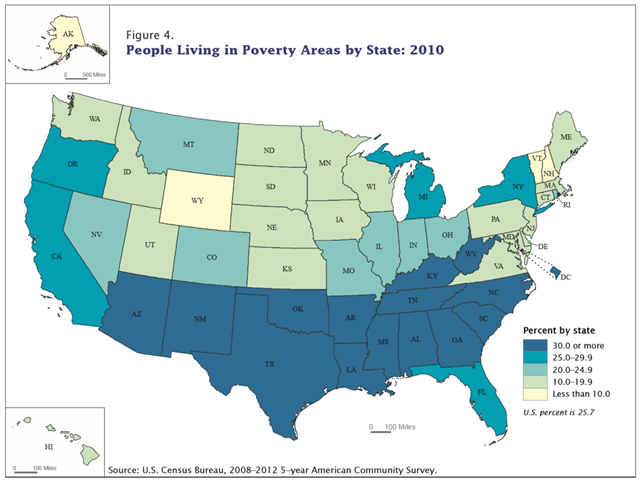| Online: | |
| Visits: | |
| Stories: |

| Story Views | |
| Now: | |
| Last Hour: | |
| Last 24 Hours: | |
| Total: | |
Graph of the Day: People living in poverty areas by U.S. state, 2010
By Alemayehu Bishaw
27 June 2014(census.gov) – The Changes in Areas With Concentrated Poverty: 2000 to 2010 report [pdf] largely compares Census 2000 poverty estimates with those based on the 2008–2012 5-year American Community Survey (ACS). As 2010 represents the midpoint of this period, for convenience the remainder of this report refers to these 2008–2012 ACS poverty statistics as 2010 estimates.
In 2010, approximately 14.9 percent of the total U.S. population lived in poverty. However, poverty is not distributed evenly across neighborhoods. There are neighborhoods in every state that have higher than average poverty rates. The U.S. Census Bureau designates any census tract with a poverty rate of 20.0 percent or more as a “poverty area.” In 2010, more than 77 million people lived in poverty areas.
Between 1990 and 2000, the percentage of people living in poverty areas fell from 20.0 percent to 18.1 percent. This trend was reversed in the past decade. Between 2000 and 2010, the percentage of people living in poverty areas grew from 18.1 percent to 25.7 percent. While the overall population grew by 10 percent over the decade, the number of people living in poverty areas grew by about 56 percent.
A recent report from The Century Foundation and the Rutgers Center for Urban Research and Education found that after substantial declines in the concentration of poverty in the 1990s, the concentration of poverty has surged once again since 2000. This report found that while concentrated poverty has returned to—and in some ways exceeded—the previous peak level of 1990, there are substantial differences in how concentrated poverty is manifested. In particular, the authors found that the residents of high poverty neighborhoods are more demographically diverse than in the past.
Various researchers have found that living in communities with a large concentration of people in poverty adds burdens to low-income families. Problems associated with living in poverty areas, such as, higher crime rates, poor housing conditions, and fewer job opportunities are exacerbated when poor families live clustered in high-poverty neighborhoods. In recognition of these burdens, some government programs target resources to these high-poverty neighborhoods. Many of these programs use the Census Bureau’s definition of “poverty areas” (census tracts with poverty rates of 20 percent or more) to identify such areas.
Census tracts are the basic geographic unit used to analyze the characteristics of the population and neighborhoods. Three previous Census Bureau reports have described the characteristics of people living in census tracts with different levels of poverty. Reports published in 1995 and 2005 analyzed data from 1990 and 2000 decennial censuses. A report published in 2011 used the 2006–2010 5-year ACS data. See text box for a description of census tracts.
This report uses data from Census 2000 and the 2008–2012 5-year ACS to analyze the changes in the spatial distribution and socioeconomic characteristics of the people living in poverty areas. The report uses two sets of distributions (of people, families, and households) to examine the changes between these years. The first set shows the distribution of everyone living in poverty areas, while the second set shows those in poverty living in poverty areas.
Changes in Areas With Concentrated Poverty: 2000 to 2010
Source: http://www.desdemonadespair.net/2014/07/graph-of-day-people-living-in-poverty.html




